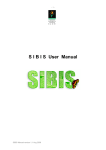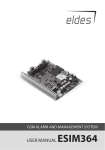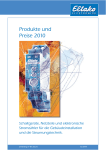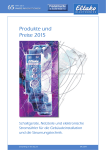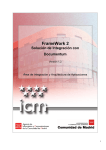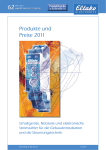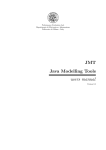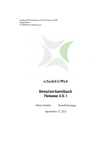Download MJ - A System for Constructing Bug-Finding Analyses for
Transcript
MJ - A System for Constructing Bug-Finding Analyses for Java
Godmar Back
Dawson Engler
Stanford University
Computer Systems Laboratory
{gback|engler}@stanford.edu
Abstract
Many software defects result from the violation of programming rules: rules that describe how to use a programming language and its libraries and rules that describe the
dos and don’ts within a given application, library or system. MJ is a language and an engine that can succinctly
express many of these rules for programs written in Java.
MJ programs are checkers that are compiled into compiler
extensions. A static analysis engine applies the extensions
to user code and flags rule violations. We have implemented
and tested several extensions in MJ for both general and
application-specific rules. Our checkers have found dozens
of bugs in some widely-deployed and mature software systems.
1. Introduction
Software has too many bugs. Recently, there has been
a significant amount of work devising automatic tools to
detect such bugs. These range from annotation-based approaches [9, 11, 17], to stand-alone tools tailored to checking specific error types [4, 19], to tools that allow users to
extend them to check new properties [2, 5, 7, 8].
Annotation-based systems have the strength of providing a form of checkable documentation, but tend to require
a heavy investment by the user before yielding good results.
In contrast, tool-based approaches tend to have a much
lower incremental cost per-checked line of code, and hence
higher bug counts (often thousands for large systems). Extensible tools have the further advantage that they can be
easily tailored to do unusual analyses (such as using statistical analysis to infer which properties to check) or to directly target identified expensive bugs to ensure they will
not be reintroduced.
The bulk of this prior work has focused on unsafe languages (i.e., C and C++). Although some bug-finding tools
for Java have been developed, most are either annotationbased and require a large amount of labor, or only check a
fixed set of properties (such as race detection), or are limited to enforcing stylistic rules (e.g., that switch statements
have at most five case arms).
This paper describes MJ, an extensible bug-finding system for checking Java. It provides users with a language and
runtime system that allows them to write extensions that are
dynamically linked into a sophisticated compiler framework
and automatically applied to bytecode. Many extensions are
less than a hundred lines of code, are easily applied to new
systems without alterations, and have found dozens of bugs
in widely-used systems.
MJ is based on the metacompilation approach [8], which
we originally developed in the context of C. This paper extends this approach to Java, demonstrating that it works well
in the context of a type-safe language. The cornerstone of
the approach is that many abstract rules have a straightforward mapping to source code. Thus, given knowledge of a
rule, a compiler extension can automatically find violations
of it. For example, the rule “calls to v.lock() must be
matched with a call to v.unlock()” can be checked by
following every path after a v.lock() call making sure
it hits an v.unlock() call. In general, checking rules
has two parts: (1) mapping the actions that are relevant
to a rule to source code and (2) expressing the rule constraints on these actions. MJ supports the first by providing
a rich, high-level pattern language that allows users to easily
match source constructs. It supports checking in two ways.
First, it provides a simple state machine-based, datafloworiented language which allows users to concisely express
constraints. While the language provides a framework, it
does not limit the analyses users can implement—users can
interweave arbitrary code to extend and customize it. Second, MJ plugs these checks into a compiler framework that
takes care of both low-level details and provides sophisticated analyses. For example, this framework automatically
reconstructs variables from bytecode-level register assignments, uses reaching definitions and other dataflow analyses
to track these variables, and performs flow-sensitive analysis.
The main contributions of this paper are:
sm stringchecker {
state decl { java.lang.String } str;
{ public HashMap tracking = new HashMap(); }
init { tracking = new HashMap(); }
1. A system and language that make it easy to write a
broad set of checkers in a unified framework.
2. Showing that common sources of bugs can be expressed succinctly within this framework: most of our
checkers are less than a hundred lines of code.
start:
{ str = java.lang.String.anymethod(...) }
==> str.tracked, {
tracking.put(str.getDefinition(), ...);
};
3. Showing that the approach is effective by using it to
find dozens of bugs in more than six different systems.
str.tracked:
{ str } ==> {
// matches any use
tracking.remove(str.getDefinition());
};
final { bugs.addAll(tracking.values()); }
}
The rest of this paper is structured as follows: Section 2
explains the syntax and semantics of MJ using three small
examples. Section 3 describes the MJ language; Section 4
describes the system in detail. Section 5 reports on our experiences with uses of specific extensions. Section 6 discusses related work, and Section 7 concludes.
Figure 2. String checker: identifies locations
where (immutable) strings are discarded
2. Overview
This section gives two motivating examples for MJ. In
Java, objects of the built-in string class are immutable. A
common source of bugs is to assume that string operations such as replace(), concat(), or trim() affect the
string objects to which they are applied, when in fact a new
string object is returned. As an example, consider the code
in Figure 1, which MJ found in Oceanstore [16], a large
software system for distributed global persistent data.
In this code snippet, the programmer tries to create a
unique message id by combining (concatenating) different
elements of a message and computing a SHA-1 hash on the
result. In reality, only the message src element is used to
compute the SHA-1 hash, making the message id not nearly
as unique (and secure) as the programmer intended. This
example demonstrates both that potentially serious logical
bugs can result from obvious violations of simple API rules
and that they can be readily detected automatically.
Figure 2 shows a simple MJ program that can
identify this and similar bugs.
It uses the pattern
java.lang.String.anymethod(...) to match code
locations where any method of the String class is invoked
with any number of parameters. Upon finding a match, the
analysis engine will bind the returned value to a state variable str, which will be tracked to all code locations that
the so-bound definition reaches. In addition, it will record
this match in a hashtable, which is accomplished by calling
out to the user-specified Java code embedded in the { ...
} clause.
Subsequently, the analysis engine will examine all locations reached by that definition to see whether they use the
returned value. This check is described using the simple
{str} pattern, which denotes any use other than simply assigning the returned value to one (or more) local variables.
It is guarded by the state str.tracked, which binds str
to only those values tracked from a previous call to a string
method. If a use is found along any path, the definition is
removed from the hashtable. After all paths have been explored, definitions that are left in the hashtable are flagged
as potential errors.
A second example illustrates MJ’s ability to perform
simple flow-sensitive analyses. In Java, a common idiom is
to check if an object reference is null, and then to derefersm nullchecker {
state decl anyobject o;
start:
{ o != null } ==> true = o.isnotnull,
false = o.isnull ;
o.isnull:
{ anyclass.anyfield = o } ==>
{ /* ignore this innocuous use */ }
// any use
| { o } ==> { err("use of null object"); } ;
o.isnotnull: { o.size() } ==>
{ /* possible size() pattern */ }
;
OceanStore ostore/tapestry/channel/ChannelRouteMsg.java:
public SecureHash generate_msg_id() {
String id = src.toString();
id.concat( dest.toString() );
id.concat( Integer.toString(channel_id) );
id.concat( Integer.toString(sequence) );
id.concat( Integer.toString(frg_index) );
msg_id = new SHA1Hash(id);
return msg_id;
}
}
Figure 3. Null checker: flags when variables
are accessed that could be null
Figure 1. Calls to id.concat do not affect id.
2
stringchecker checks that results of string manipulations
aren’t discarded, warns if non-interned strings are
compared, warns if unneeded copies are made
JDK 1.4 javax/swing/LayoutComparator.java:
if (a == null) {
// ’a’ is not part of a Window hierarchy.
Can’t cope.
throw new ClassCastException(a.toString());
}
droppedexceptions warns if exceptions aren’t thrown
apples&oranges warns if Object.equals() is invoked on incompatible objects
Rhino 1.5 RC5 org/mozilla/javascript/IRFactory.java:
nullchecker warns if a pointer known to be or possibly null
is dereferenced.
String s = id.getString();
if (s != null && s.equals("__proto__")
|| s.equals("__parent__")) { ... }
lockunlock checks that calls to lock/unlock methods are
paired on all paths.
Jigsaw 2.2.2 org/w3c/jigsaw/filters/UseProxyFilter.java:
Reply r = request.makeReply(HTTP.USE_PROXY);
if (r != null) {
/* ... */
r.setStream(g);
}
r.setLocation(proxy_url);
return r;
signedbyte warns of potentially wrong sign-extension.
superfinalizer warns if finalize() method doesn’t call super.finalize() on all paths
staticlock warns when a public static field is used as a lock.
Figure 4. Typical null checker bugs
neverused flags redundant operations
nullargs infers statistically if arguments must be checked
for null
Table 1 shows a list of checkers we implemented to
demonstrate the flexibility and applicability of MJ. The
checkers shown are generally small (the median number of
lines is 68), the largest checker (neverused) is 391 lines, the
majority of which is code that relates to statistical ranking
and HTML presentation. Table 2 shows the codebases over
which we ran our checkers. On a 1.13GHz PC with 2 GB of
RAM using Sun’s JDK 1.4 Hotspot VM, it took between a
few seconds and 2 minutes to run these checkers, depending
on the codebase.
Table 1. Examples of the types of properties
that can be checked by short MJ programs
ence the reference only on those paths where it is not null.
Not following this idiom is often a bug that can crash the
current thread or application. Figure 3 shows an MJ program that can detect such violations. This checker matches
conditional branches that depend on the outcome of a comparison with null. Different variable states are propagated
along the true (isnull) and false (isnotnull) edges in
the control flow graph, carrying with them the flow-related
information about the outcome of the test. If a subsequent
use of this object reference is found along a path that is
reachable from the isnull edge, the checker flags this as a
possible bug. Figure 4 shows three typical bugs this checker
found in mature and widely-used software systems.
MJ extensions are not verifiers and can miss errors. Conversely, they may report false positives. MJ language features can be used to identify and suppress certain false positives. For instance, we found that the nullchecker produces
a number of false positives for Java collection types if the
programmer treated a null reference similar to a collection with zero elements. In these cases, the null check was
followed by a call to a method such as size() on the nonnull path. The result of size() was then used to guard
against the potentially dangerous access. Adding a MJ pattern {o.size()} guarded by the ”o.isnotnull” state allows
us to recognize this particular false positive easily.
OceanStore A distributed global persistent storage system,
CVS Jan 2003, 166K
JDK 1.4 javax javax.* hierarchy in JDK 1.4.1, including
the Swing GUI, 132K
Ptolemy A system for simulation, version II 2.0.1, 87K
Jigsaw W3C’s webserver, version 2.2.2, 68K
OpenMap OpenMap 4.6beta Sep 2003 by BBN Technologies [3], 124K
Mozilla Rhino JavaScript engine, version 1.5 RC5, 31K
Netbeans A integrated IDE for Java, CVS May 2003,
217K
Table 2. Code bases to which we applied our
checkers. The line numbers are the estimated
effective number of lines as computed from
the line number information in the bytecode
3
3. The MJ Language
MJ Compiler
Java Code
MJ program
The MJ system consists of a description language for
analyses, a compiler that turns these analyses into compiler
passes, and runtime support for processing and presenting
analysis results. Its basic structure is shown in Figure 5. To
analyze code using the MJ system, a user merely has to load
its bytecode into the J OEQ environment, which requires the
same actions needed to run it, such as placing jar files and
setting up classpaths.
An MJ checker is compiled to Java code by the MJ compiler. The compiled Java code, along with the MJ runtime,
is dynamically loaded by the J OEQ analysis framework.
The MJ runtime provides support for accessing J OEQ internals. A library ranks and presents analysis results; its output
can be either plain text for quick analyses, XML for processing in a bug database, or HTML. The produced HTML
links to the original source code, marking the flagged lines
in color for easy inspection.
MJ runtime
bytecode−IR
.class file
loader
.java file
joeq
compiler
pipeline
Analysis Results
Figure 5. Overview of the MJ system
flagging a false positive if the programmer used an idiom such as “if (o == null) System.exit(1);” followed by an access to o.
3.1. Pattern Matching
The MJ language is based on the metal checking language we developed for checking C code [13]. MJ programs use a state machine abstraction that is combined with
traditional dataflow analysis [18]. A programmer can specify patterns that match Java source code constructs, such as
method invocations, field accesses etc. Patterns are associated with actions, which are performed if a location matching the pattern is encountered in bytecode. An action may
propagate a new global state to source locations that are
reachable from the location matched.
Patterns may contain references to typed state variables
declared in the MJ program. If a pattern containing such a
variable is matched, the variable is bound to the operand in
whose place it occurs. If the analysis associates a state with
a variable, the resulting state variable is propagated to all
locations that this operand reaches.
Patterns are guarded by states, which are either global
states or those of state variables. For instance, in Figure 2,
the pattern { str } is guarded by state str.tracked. If
a pattern is guarded by a state, a match is only possible at
those locations that are reached by the guarding state. If
a state guards multiple patterns, which must be separated
by a “|” character, the analysis engine matches patterns in
the order in which they are listed. A special start state is
assumed to reach all locations. A special stop state may
be used to stop the propagation of a state variable. For instance,
Table 3 shows some examples of legal patterns. These
include arithmetic operations, comparisons of scalars and
references, array reads and writes, object allocations, type
tests (instanceof), type casts, method invocations (including
calls to initializers, static methods and the super.* calling
convention), field accesses, and others. For field accesses
and method invocations, a programmer may use regular expressions to specify the field and method name; for instance,
"ˆset.*"(...) will match all set methods with any
number of arguments. In addition, we support several kinds
of wildcards: anymethod, anyfield, anyclass, anyobject, and anyvalue. Special patterns are used for entering
and leaving synchronized blocks and for paths that leave a
current method.
Pattern matching relies on compile-time type information. We follow the intuition that a programmer would have
about the types of the objects involved. When matching a
method invocation or field access, we match sites where the
object’s compile-time type is compatible with the type specified. For object allocations, we require that the type be the
same. A special keyword anynew matches allocation sites
that are merely compatible with the type given. A special
modifier exact restricts call sites and field accesses to the
exact compile-time type.
If an analysis cannot be expressed in the pattern and state
model that MJ supports directly, then a programmer may
use callouts written in Java. A special ${...} pattern allows a user to specify arbitrary Java code that is invoked
when the analysis engine needs to determine if an action
should be triggered at a given location.
o.isnull:
{ static java.lang.System.exit(int) } ==> o.stop
prevents the propagation of variable state o.isnull when
a call to exit() is seen, preventing the nullchecker from
4
Examples of declarations
state
state
state
state
decl
decl
decl
decl
cilitate research in virtual machine and compilation technologies. We use its frontend to load Java bytecode, which
allows us to add our analyses as passes to its compiler.
Because J OEQ was designed with extensibility in mind it
makes extensive use of the visitor design pattern [12]. J OEQ
is itself implemented in Java, so adding a pass is as simple
as writing a specific visitor class for J OEQ’s intermediate
representation (IR).
A MJ program is compiled into a set of Java classes that
implement a specialized intraprocedural forward dataflow
analysis. A static skeleton class provides the frame for the
analysis, the generated program subclasses from this skeleton. The skeleton provides the basic framework for traversing the control flow graph and computing dataflow facts,
compiler-generated subclass implements the specific transition function given by the MJ program. User-provided
code is enclosed in methods of that subclass and invoked
as needed. The translated MJ program uses the underlying
J OEQ infrastructure.
Using J OEQ benefits us in several ways: first, it performs the mundane task of Java class loading, including
the resolution of link-time references. More importantly,
it allows us to make seamless use of other analysis components, such as class hierarchy analysis, that have been
implemented within or for the J OEQ framework.
anyobject o;
anyvalue r;
{ int } v;
{ java.io.File } f;
Examples of patterns
java.lang.String.anymethod(...) matches
all
method calls on a String object with any number of
arguments
static java.lang.System.exit(int) matches calls
to System.exit() with one integer argument
super.finalizer() matches all calls to super.finalizer()
f = anyclass.anymethod(...) matches any method
returning a java.io.File object
r = anyobject.".*[Ff]lag.*" matches all reads
from fields that have flag or Flag in their field name
v = byte[int] matches reads from a byte array
return v matches return statements that return v
v | int matches any bitwise or of v with an integer
operand
4.2. Dataflow Formulation
new Type() matches any allocation of Type objects
MJ’s dataflow analysis computes dataflow facts for each
quad instruction in J OEQ’s IR. Quads are a form of fouraddress-code; operands are registers, constants, or types.
Quad IR uses a similar instruction set as Java bytecode:
for instance, a getfield (read from instance field) bytecode instruction is translated into a GETFIELD quad. The
main difference between bytecode and quad IR is that the
bytecode-to-quad translation replaces Java’s stack-based
execution model with a more convenient to use registerbased model. Every local variable, incoming parameter, and
stack location is assigned a register.
MJ patterns match individual quad instructions in
J OEQ’s IR. Because the Java source-to-bytecode translation preserves most of a program’s semantics, we can easily
identify most source patterns in the quad representation. We
use the line number information and local variable tables (if
available) to map quads and registers back to source code
lines and local variables.
We implement the dataflow analysis using a traditional
worklist algorithm. Each quad has an associated state
cache, which includes global states and those bound to a
state variable. Global states are represented as integers. A
variable state is a tuple (v.i, def, set) where v represents
the state variable in the MJ program, v.i the integer representing the state v is in, and def represents the source lo-
(Type)o matches any cast of o to Type
o == null matches any test of o against null
lock o matches the beginning of synchronized(o) block
Table 3. Examples of declarations and patterns MJ supports
4. MJ’s Runtime Environment
MJ programs are translated into specialized dataflow
problems. State propagation is modeled as a dataflow problem whose transfer function creates states for code locations
as needed, and perform a combined reaching definitions
analysis to track variable states to the locations they reach.
In this section, we explain how our generated code implements these algorithms. We give some necessary background on the J OEQ compiler infrastructure first.
4.1. The J OEQ Infrastructure
J OEQ [20] is a component framework designed to fa5
cation where the variable was bound. A definition is a pair
(quad, reg), meaning that this variable was bound to register reg at quad quad. regset represents the set of registers
that the so-defined register can reach.
The set of states held in a quad’s state cache represents
the in set for that quad in the dataflow analysis. Our generated code computes the transfer function for a quad as
follows. For each global state in its in set, we examine if
any of the patterns guarded by that state match this quad.
If the quad does not match the pattern, the global state is
propagated to all successor quads. If there is a match, the
action associated with the match dictates what function is
to be executed. If the action describes a new global state
other than the stop state as its target, a new global state is
created and propagated to all or some successors.
If the action targets a state variable, a new variable state
is created that is bound to the registers that contained the
operands that matched the position of the state variable in
the MJ program. For instance, consider the o != null
pattern shown in Figure 3 in conjunction with the following
quad with quad id #2. This quad is a conditional branch
that jumps to label BB7 if register R2 is not equal to null:
#2
state variable declaration, the user tells the runtime system to use instances of a user-provided class to represent
states instead of the default, system-provided implementation. For instance, state decl { int } typeflag
use DependentStateVariable; tells the MJ runtime
to instantiate objects of the user class DependentStateVariable when tracking instances of typeflag. The
user-provided class is responsible for implementing the
dataflow analysis methods that implement the transfer function across a quad and the confluence function that is used
when merging successor states.
4.4. Limitations
Instead of basing our pattern matching on the quad IR,
we could have modified a Java source frontend to match
source code directly. Aside from the obvious advantage
that working with compiled code enables analyses in the absence of source code, using quads also simplifies the matching of patterns that may occur in different variations. For
instance, a pattern such as a < b will also match if the
source code contained a negated pattern such as b >= a,
because their representations at the IR level are identical.
A disadvantage of quad matching is that a few source
constructs generate multiple quads. For instance, an object
allocation using the new operator is translated into a NEW
quad instruction, followed by an INVOKESPECIAL instruction to call the respective constructor. A MJ programmer
may decide to match on either instruction, depending on
the analysis.
A second example of more complex matching are instanceof type inclusion tests. These are not directly translated into a branch instruction: instead, the result of the
test is stored in a register, which is subsequently tested in
a branch. In this case, a state variable needs to keep track of
two registers: the register that holds the reference to the object to which the type test was applied, and the register that
holds the boolean result of the test. We use a user-defined
state variable as described in Section 4.3 to implement this.
IFCMP_A R2 Object, AConst: null, NE, BB7
In the null checker, the transfer function for this quad
will propagate variable state (o.isnotnull, (#2, R2), R2)
to the quad at label BB7, and it will propagate variable
state (o.isnull, (#2, R2), R2) to the fallthrough quad of
the branch.
Variable states that are in the in set of a quad require
additional handling: first, when deciding whether a quad
matches the pattern guarded by such a state, we need to also
check whether any of the registers in the variable state’s register regset may reach the register that is used in place of
the bound variable v. Second, even if there is no match,
we need to compute reaching definitions in parallel by
adding copied registers to a state’s regset and by removing a quad’s killset from the state’s regset. If the regset
becomes empty (that is, if the definition to which the variable was bound is dead), the state is killed.
The confluence operator for our dataflow analysis is the
union of the regsets computed individually for each (v.i,
def) pair. In other words, we merge register sets at join
points if they represent the same variable state and if they
were bound at the same location in the quad code.
5. Applications
This section presents a suite of checkers written using
MJ. These checkers give a feel for the variety of checks
that can be expressed in the MJ framework.
4.3. User-Defined States
5.1. Checking Language-specific Properties
For cases where the provided state model is too restrictive, we provide a way for users to extend and customize
how MJ creates and propagates states. For instance, a
user may wish to track additional, dependent definitions
along with a state variable. By adding a use clause to a
MJ extensions do not have be involved to be useful.
Some language-specific rules can be expressed very succinctly. For instance, in Java, while all objects can be compared using Object.equals(), typically the comparison
make only sense if the compile-time type of the objects are
6
sm lockunlock {
state decl anyobject v;
Bug caused by using equals() on incompatible types
boolean filterComment()
{
User user = User.getUser();
Document d = getContainingDocument();
return !user.equals(d.getAuthor());
}
start:
{ v."lock"(...) } ==> v.locked;
v.locked:
{ v."unlock"(...) } ==> v.stop
| $end_of_path$ ==> {
/* flag error */ };
}
Short checker that found this bug:
sm applesandoranges {
decl anyobject objl, objr;
Figure 8. Lock checker: flags where intraprocedural lock/unlock pairing is violated
start:
{ objl.equals(objr) } ==> {
// warn if !objl.type.isCompatible(objr.type);
}
}
violated: by placing the call to B into the finally clause, the
programmer ensures that B is called no matter which path
is taken to leave the try block.
Nevertheless, the compiler cannot enforce proper use of
try/finally. Figure 7 shows a bug in Jigsaw 2.2.2 where the
programmer mistakenly placed the required call to unlock
in a catch instead of a finally clause.
Figure 8 shows a simple MJ program that detected this
bug: this checker matches invocations of v.lock() and
tracks the locked instance v. If a call to unlock() is encountered that is invoked on the same object, we stop tracking the object. If a tracked object reaches $end of path$ ,
i.e., an edge in the control flow graph that leaves the current
function, a potential error is signaled.
This error occurred despite a comment by the implementer of the ResourceReference interface that explicitly recommends the use of the try/finally pattern when using this interface. The length of that comment is about the
same as the length of checker; we conclude that analysis
tools such as MJ could be used as enforceable documentation. It is also possible to develop checkers in conjunction
with the use of automatic interface extraction tools, such
as [21].
Figure 6. Bug caused by using equal() on
incompatible types, resulting in loss of confidentiality in a commercial system.
related; otherwise, the implementation of equals() may either crash or, worse, silently return false, leaving a possible error untrapped.
Figure 6 shows a security hole caused by violating this
rule and a checker that found it. The shown filterComment() method is part of a code base of a leading enterprise software system. The method’s purpose is to determine whether a user requesting a document is authorized
to see comments that should be visible only to the author.
In this case, the consequence of this bug was a breach of
confidentiality, exposing these comments to all viewers.
5.2. Checking Interface Properties
Many APIs have the property that a call to A must be followed by a call to B. For instance, calls to lock() must be
paired with calls to unlock(). Java provides the try/finally
construct to reduce the likelihood that such properties are
5.3. Redundant Operations
Redundancies, such as redundant assignments, have
been shown to be correlated with actual bugs in C code [22].
To test whether this holds true for Java code as well, we
implemented an MJ extension, neverused, that identifies
such redundancies.
Figure 9 shows an example of a bug this checker found
in the OceanStore system: a function that needs to update a value in a hashtable did not, presumably because
the programmer mistakenly assumed that an assignment
to a reference that was obtained from the hashtable via
get() would affect the value stored in the hashtable. Our
checker flags this example because the result of the call to
msg.getMsgs() is never used.
Jigsaw org/w3c/jigsaw/proxy/ProxyFrame.java:
try {
DirectoryResource dir =
(DirectoryResource)root.lock();
...
} catch (InvalidResourceException ex) {
root.unlock();
}
Figure 7. Mismatched pairing: the programmer placed the call to unlock() in the catch
instead of a finally block.
7
OceanStore ostore/apps/visdemo/Visdemo.java:
pattern {anynew java.lang.Throwable()} allowed for
easy identification of allocation sites of all throwables. This
example demonstrates a strength of MJ: it makes it easy to
create checkers tailored to specific bug patterns that emerge
while analyzing actual code.
public void registerReqMsg(SonarReqMessage msg) {
SecureHash treeId = ... /* ... */
QSVector network_msg =
(QSVector)_network_msgs.get(treeId);
if(msg.getType() == SonarReqMessage.NETWORK &&
network_msg != null)
network_msg = msg.getMsgs();
/* network_msg is dead here, needed was:
_network_msgs.put(treeId, network_msg) */
5.4. Inferring Application-specific Properties
MJ also allows the construction of analyses that infer
programming rules from programmer behavior. For instance, different implementations of a virtual method of a
class or interface are expected to abide by the same contract.
Most implementations are error-free and will exhibit similar
behavior. Implementations that deviate from the dominant
behavior are likely bugs.
As an example of such an analysis, we analyzed how
methods treated object references they received as arguments. We modified our nullchecker to track incoming
parameters and recorded if a parameter was checked and
dereferenced (C), or dereferenced unchecked (U ), or not
dereferenced at all. We only included virtual and interface
methods with more than one implementation and grouped
methods by their shared supermethod. We expect that if
a parameter is almost always checked before being dereferenced, then dereferencing it without checking is a bug.
Conversely, if it is almost always accessed without a check,
the check might be redundant.
For instance, in OpenMap we identified 5 methods for
which C 6= 0 and U 6= 0. We used statistical analysis
to sort the results based on the ratio of C/(C + U ), adjusted for total number. The three top-ranked entries had
C1 = 23, U1 = 1, C2 = 23, U2 = 1, C3 = 17, U3 = 2.
The developers of OpenMap confirmed that all 4 unchecked
accesses were indeed bugs. For the other packages we analyzed, the analysis failed to find obvious bugs that we could
confirm without deeper knowledge of the system.
}
Figure 9. A bug from a redundancy: a return
result is never used
Our checker looks for instance and static field reads, object allocations, and instance and static method invocations
whose results are never used. We ran this checker over our
codebases; we found that reads from static fields that are
unused are often the result of defensive programming: a
programmer might initialize a local variable to some safe
value. We found numerous instances of unused reads of instance fields; in some cases one field is read but a different
field is used.
To determine whether a method call or object allocation whose return value is discarded is a bug or not, we
attempted to use statistical ranking [15]. We compared the
number of sites n where a given method or constructor was
invoked to the number of sites e where the return value of
the invocation was used. The underlying assumption is that
if a method’s result is used almost all of the time, then the
instances in which it is discarded are likely errors. We found
that using statistical ranking in this way worked well in that
it pushed redundant calls to the top. We were surprised by
the sheer number of redundant calls that can be found in
mature Java code. However, statistical ranking did not push
the most serious bugs to the top; most top-ranked redundant calls were simply inefficiencies: a programmer would
ignore and then repeat the call. Still, we believe that a diligent programmer would want to inspect all such instances
and clean them up.
To our surprise, we found that a particular class of bugs
showed up at the top of the ranking for unused objects:
namely exceptions. Unused exceptions typically occur if a
programmer forgets a preceding throw keyword. For instance, in Ptolemy, objects of type ptolemy.kernel.util.IllegalActionException are used 838 out of
839 times, ranking the one occurrence where a programmer erroneously omitted the throw at the top. After having the obvious-in-hindsight realization that exceptions are
practically never constructed for side-effect, we wrote a
smaller checker that identifies this very case. The MJ
5.5. Generalizing Identified Bugs
Easy-to-use tools such as MJ can change the way programmers write test cases for bugs they encounter and fix.
boolean checkIPRange(Request r, User u) {
byte abyte0[] = ... get IP address
/* ... */
long l = 0L;
for(int i = 0; i < 4; i++)
l = l << 8 | abyte0[i];
/* ... */
}
Figure 10. Bug caused by Java’s automatic
sign extension
8
sm badbyteor {
state decl { int } x;
state decl { long } lx;
5.6. Summary of Results
Figure 12 summarizes the number of bugs that were
found by four of our checkers that check language-specific
properties. We only counted those bugs that were either
confirmed by the developers or that we could verify without knowledge of the system in question. For the A&O
and the nullchecker, we also list the number of false positives (FPs), and potential bugs or redundant checks (labeled “Bugs?”). A major cause of false positives for the
nullchecker are false paths, which we expect to rectify by
including path-sensitivity to our analysis. The table does
not include the bugs we found with more specialized analyses, and it does not include the many anomalies found by the
neverused checker, which included several confirmed bugs.
It also does not include the bugs found in the commercial
closed-source codebase.
start:
{ x = byte [ int ] } ==> x.castfrombyte;
x.castfrombyte:
{ lx = (long)x } ==> lx.castfrombyte
| { x | int } ==> {
/* possible error */ }, x.stop;
lx.castfrombyte:
{ lx | long } ==> {
/* possible error */ }, lx.stop;
}
Figure 11. Checker that flags if a value read
from a byte array is ORed with an int or long
An anecdote illustrates this conviction. A colleague working for an ecommerce company asked the first author for
help with a problem in a third-party library used to implement IP-address based access control. Figure 10 shows
a decompiled picture of the relevant code portion. Their
code worked fine on the company’s internal (10.0.0.x) network, but failed for a customer who used IP addresses in
the range 160.x.x.x, whose representation in a byte array
contains negative values (160 = -96). The bug was caused
because a programmer disregarded Java’s rules for sign expansion: all scalars, including bytes, in Java are signed, and
promotion to int or long extends the sign, which flooded
the higher-order bits of the IP address with 1s.
Figure 11 shows a MJ program that captures the essence
of this bug. In the start state, it matches all reads from byte
arrays. The integer value read from the array is tracked in
a state variable. The program flags if that value is used in a
bitwise OR. (If the programmer means to treat the value as
an unsigned value, it would likely be used in a bitwise AND
with constant 0xff.) To account for the situation shown in
the example, we also match the case where the value is cast
to a 64-bit long, track the resulting long value and flag if
that long value is used in a bitwise OR comparison. Having written this checker, we tested it against our other code
bases. Indeed, in Jigsaw class org.w3c.www.mux.MuxReader, we found this statement
6. Related Work
A variety of bug detection and checking tools have
been developed for unsafe languages such as C and C++.
These include annotation-based approaches [9, 11], tools
that cover a specific set of error types [4, 19], such as buffer
overrun errors, and to tools that allow users to extend them
to check new properties [2, 5, 7, 8]. In the remainder of this
section, we focus on the work that has been done in the Java
context.
The most closely related project to ours is the FindBugs [14] system. FindBugs is a framework for writing
bug detectors for Java code. It provides an API to plugins
that check for particular bug patterns, and like MJ provides
support for presenting bugs to the user. Unlike MJ, FindBugs does not provide language support for writing bug
detectors. All bug detector plugins have to be written in
Java and must interact with FindBugs’s API. Another difference is that FindBugs is based on a bytecode-engineering
library [6] and does not have the support of an underlying
compiler infrastructure like J OEQ.
Jlint and Jlint2 [1] are other examples of tools that support a fixed set of analyses. Jlint2 has been used successfully to find concurrency-related and other bugs in Java code
using global static analysis.
ESC/Java and Houdini [10, 17] are annotation-based
tools that use a theorem prover to check invariants in Java
code. While ESC/Java is able to prove much stronger properties, requiring annotations limits its scalability.
a[i] = (buffer[bufptr] |
(buffer[bufptr+1] << 8)) & 0xffff;
in method msgShortArrayToIntArray().
This example shows that MJ programs can in some cases
take the place of unit tests: a programmer who finds and
fixes an unexpected bug can generalize the underlying root
cause of the bug in a checker.
7. Conclusion
Static analysis is a promising method for finding and
eliminating bugs at compile time in Java. Key for making
9
Package
LoC
OceanStore
JDK 1.4 javax
Ptolemy
Jigsaw
OpenMap
Mozilla Rhino
Netbeans
Total
166K
132K
87K
68K
124K
31K
217K
825K
stringchecker
5
1
4
4
4
0
4
22
droppedexceptions
0
0
1
0
19
0
2
22
apples&oranges
Bugs
FP
2
0
0
2
0
0
0
1
0
0
0
0
0
3
2
6
nullchecker
Bugs Bugs?
5
5
9
2
1
1
1
13
8
4
1
4
3
5
28
34
Total Bugs
FP
13
22
1
13
0
3
18
70
12
10
6
5
31
1
9
74
Figure 12. Bugs and false positives from four of our generic checkers.
static analysis work is the availability of flexible tools that
allow developers to devise specific analyses for the specific
sources of problems that exist within their application or
system. MJ allows the construction of such analyses; we
have demonstrated its flexibility by applying it to a variety
of bug-finding analyses.
[11] J. Foster, T. Terauchi, and A. Aiken. Flow-sensitive type
qualifiers. In Proc. of the ACM SIGPLAN 2002 Conference on Programming Language Design and Implementation, June 2002.
[12] E. Gamma, R. Helm, R. Johnson, and J. Vlissides. Design
Patterns: Elements of Reusable Object-Oriented Software.
Addison-Wesley Publishing Company, 1995.
[13] S. Hallem, B. Chelf, Y. Xie, and D. Engler. A system and
language for building system-specific, static analyses. In
Proc. of the ACM SIGPLAN 2002 Conference on Programming Language Design and Implementation, 2002.
[14] D. Hovemeyer and B. Pugh. FindBugs - a bug pattern detector for Java. http://www.cs.umd.edu/˜pugh/java/bugs/.
[15] T. Kremenek and D. Engler. Z-Ranking: Using statistical
analysis to counter the impact of static analysis approximations. In Proc. of the 10th Annual International Static Analysis Symposium (SAS 2003), San Diego, CA, June 2003.
[16] S. Rhea, P. Eaton, D. Geels, H. Weatherspoon, B. Zhao, and
J. Kubiatowicz. Pond: the OceanStore prototype. In Proc. of
the 2nd USENIX Conference on File and Storage Technologies (FAST ’03), San Francisco, CA, Mar. 2003.
[17] K. Rustan, M. Leino, G. Nelson, and J. Saxe. ESC/Java
user’s manual. Technical note 2000-002, Compaq Systems
Research Center, Oct. 2001.
[18] J. D. Ullman. A survey of data flow analysis techniques. In
Second USA-Japan Computer Conference, pages 335–342,
1975.
[19] D. Wagner, J. S. Foster, E. A. Brewer, and A. Aiken. A
first step towards automated detection of buffer overrun vulnerabilities. In Networking and Distributed System Security
Symposium 2000, San Diego, CA, Feb. 2000.
[20] J. Whaley. Joeq: A virtual machine and compiler infrastructure. In Proc. of the SIGPLAN Workshop on Interpreters,
Virtual Machines and Emulators (IVME03), San Diego, CA,
June 2003.
[21] J. Whaley, M. Martin, and M. Lam. Automatic extraction of
object-oriented component interfaces. In Proc. of the ACM
International Symposium of Software Testing and Analysis,
pages 218–228, Rome, Italy, July 2002.
[22] Y. Xie and D. Engler. Using redundancies to find errors. In
Proc. of the Tenth ACM SIGSOFT Symposium on Foundations of Software Engineering (FSE 2002), Charleston, SC,
Nov. 2002.
References
[1] C. Artho and A. Biere. Applying static analysis to largescale, multi-threaded java programs. In Proc. of the 13th
Australian Software Engineering Conference (ASWEC’01),
pages 68–75, 2001.
[2] T. Ball and S. Rajamani. Automatically validating temporal
safety properties of interfaces. In SPIN 2001 Workshop on
Model Checking of Software, May 2001.
[3] BBN Technologies. OpenMapTM . A JavaBeansTM -based
toolkit for geographical applications, http://openmap.bbn.com.
[4] W. Bush, J. Pincus, and D. Sielaff. A static analyzer for
finding dynamic programming errors. Software: Practice
and Experience, 30(7):775–802, 2000.
[5] H. Chen and D. Wagner. MOPS: an infrastructure for examining security properties of software. In Proc. of the 9th
ACM Conference on Computer and Communications Security, pages 235 – 244. ACM Press, 2002.
[6] M. Dahm et al. Byte code engineering libray (BCEL).
http://jakarta.apache.org/bcel/.
[7] M. Das, S. Lerner, and M. Seigle. Path-sensitive program
verification in polynomial time. In Proc. of the ACM SIGPLAN 2002 Conference on Programming Language Design
and Implementation, Berlin, Germany, June 2002.
[8] D. Engler, B. Chelf, A. Chou, and S. Hallem. Checking system rules using system-specific, programmer-written compiler extensions. In Proc. of the Fourth Symposium on Operating Systems Design and Implementation, Sept. 2000.
[9] D. Evans and D. Larochelle. Improving security using extensible lightweight static analysis. IEEE Software, 19(1):42–
51, January/February 2002.
[10] C. Flanagan, K. Rustan, and M. Leino. Houdini, an annotation assistant for ESC/Java. In Symposium of Formal Methods Europe, pages 500–517, Mar. 2001.
10











